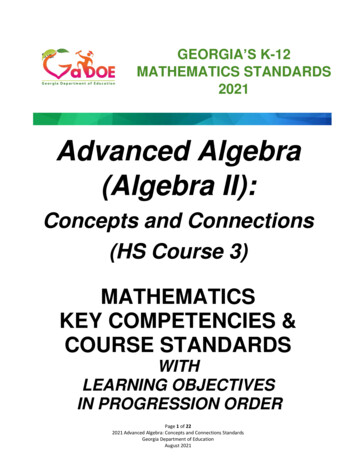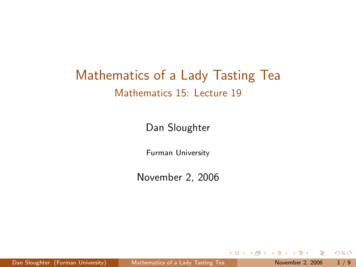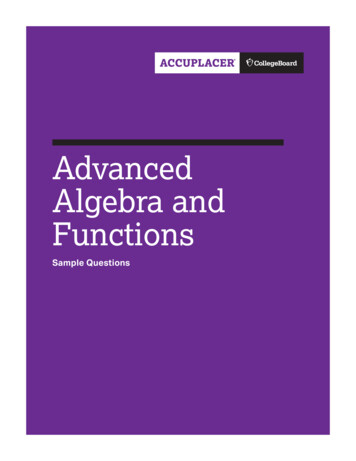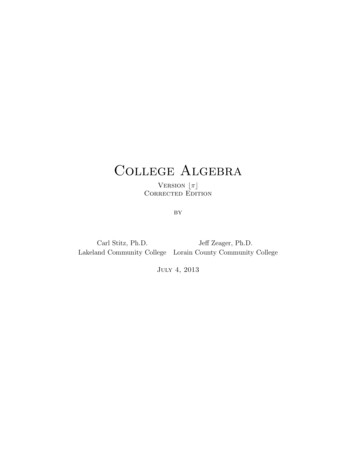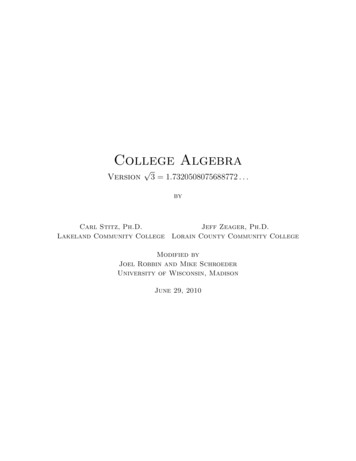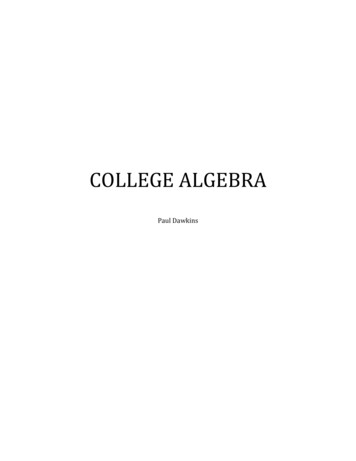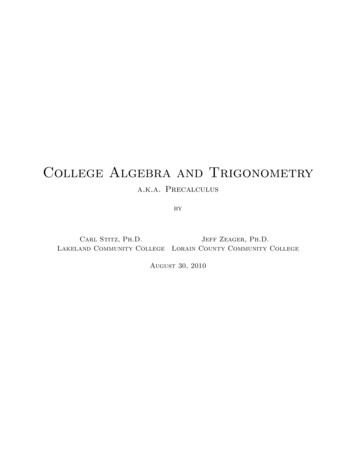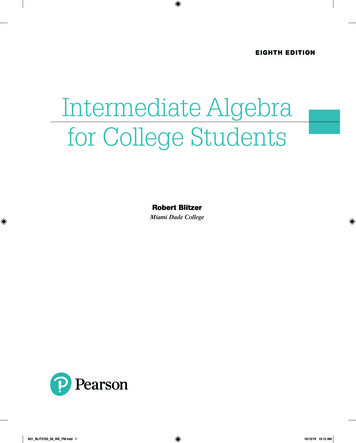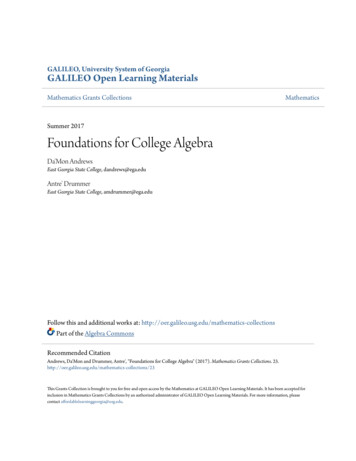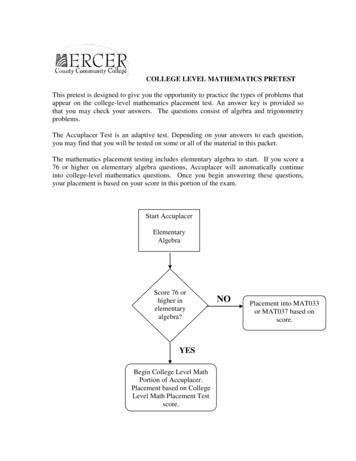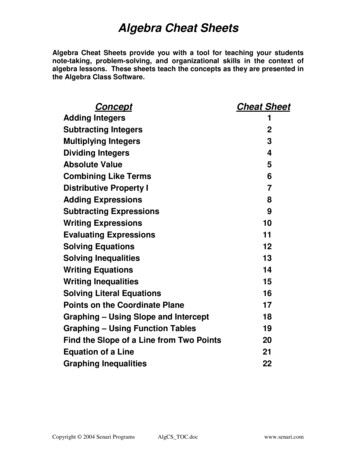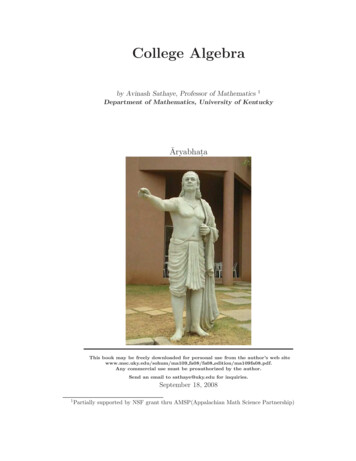
Transcription
College Algebraby Avinash Sathaye, Professor of Mathematics1Department of Mathematics, University of KentuckyĀryabhat.aThis book may be freely downloaded for personal use from the author’s web sitewww.msc.uky.edu/sohum/ma109 fa08/fa08 edition/ma109fa08.pdf.Any commercial use must be preauthorized by the author.Send an email to sathaye@uky.edu for inquiries.September 18, 20081Partially supported by NSF grant thru AMSP(Appalachian Math Science Partnership)
ii
iiiIntroduction.This book represents a significant departure from the current crop of commercialcollege algebra textbooks. In our view, the core material for the (non-remedial)courses defined by these tomes is but a shadow of that traditionally covered materialin a reasonable high school program. Moreover, much of the material is substantiallyrepeated from earlier study and it proceeds at a slow pace with extensive practice anda large number of routine exercises. As taught, such courses tend to be ill-advisedattempts to prepare the student for extensive calculations using calculators, withsupposed “real life” examples offered for motivation and practice. Given the limitedtime and large number of individual topics to study, the average student emerges,perhaps, with the ability to answer isolated questions and the well-founded view thatthe rewards of the study of algebra (and of mathematics in general) lie solely in theexperience of applying opaque formulas and mysterious algorithms in the productionof quantitative answers.As rational, intelligent individuals with many demands on their time, students insuch an environment are more than justified when they say to the teacher: “don’ttell me too many ways of doing something; don’t tell me how the formula is derived;just show me how to do the problems which will appear on the test!. Individuals, whoexperience only this type of mathematics leave with a static collection of tools andperhaps the ability to apply each to one or two elementary or artificial situations. Inour view, a fundamental objective of the students mathematical development shouldbe an understanding of how mathematical tools are made and the experience ofworking as an apprentice to a teacher, learning to build his or her own basic toolsfrom “the ground up. Students imbued with this philosophy are prepared to profit asmuch from their incorrect answers, as from their correct ones. They are able to view asmall number of expected outcomes of exercises as a validation of their understandingof the underlying concepts. They are further prepared to profit from those “real worldapplications through an understanding of them as elementary mathematical modelsand an appreciation of the fact that only through a fundamental understanding ofthe underlying mathematics can one understand the limits of such models. Theyunderstand how to participate in and even assume responsibility for their subsequentmathematical education.This text is intended to be part of a College Algebra course which exposes studentsto this philosophy. Such a course will almost certainly be a compromise, particularlyif it must be taught in a lecture/recitation format to large numbers of students.The emphasis in this course is on mastering the Algebraic technique. Algebrais a discipline which studies the results of manipulating expressions (according to aset of rules which may vary with the context) to put them in convenient form, forenhanced understanding. In this view, Algebra consists of looking for ways of findinginformation about various quantities, even though it is difficult or even impossible toexplicitly solve for them. Algebra consists of finding multiple expressions for the samequantities, since the comparison of different expressions often leads to new discoveries.
ivHere is our sincere request and strong advice to the reader: We urge the readers to approach this book with an open mind. If you do, thenyou will find new perspective on known topics. We urge the reader to carefully study and memorize the definitions. A majorityof mistakes are caused by forgetting what a certain term means. We urge the reader to be bold. Don’t be afraid of a long involved calculation.Exercises designed to reach an answer in just a step or two, often hide the truemeaning of what is going on.As far as possible, try to do the derivations yourself. If you get stuck, look upor ask. The derivations are not to be memorized, they should be done as a freshexercise in Algebra every time you really need them; regular exercise is goodfor you! We urge the reader to be inquisitive. Don’t take anything for granted, until youunderstand it. Don’t ever be satisfied by a single way of doing things; look foralternative shortcuts. We also urge the reader to be creatively lazy. Look for simpler (yet correct, ofcourse) ways of doing the same calculations. If there is a string of numericalcalculations, don’t just do them. Try to build a formula of your own; perhapssomething that you could then feed into a computer some day.A warning about graphing. Graphs are a big help in understanding the problem and they help you set up the right questions. They are also notorious for misleading people into wrong configurations or suggesting possible wrong answers. Nevertrust an answer until it is verified by theory or straight calculations.Calculators are useful for getting answers but in this course most questions aredesigned for precise algebraic answers. You can and should use the calculators freelyto do tedious numerical calculations or to verify your work or intuition. But youshould not feel compelled to convert every answer into a decimal number, howeverprecise. In this course68and1 1 (2) are perfectly acceptable answers unless the(7)instructions specify a specific form. A computer system which is capable of infiniteprecision calculations can be used for study and is recommended. But make sure thatyou understand the calculations well.A suggestion about proofs. We do value the creation and understanding ofa proof, but often it is crucial that you get good at calculations before you knowwhat they mean and why they are valid. Throughout the book you will find sectionsbilled as “optional” or “can be omitted in a first reading”. We strongly urge that youmaster the calculations first and then return to these for further understanding.In many places, you will find challenges and comments for attentive or alert readers. They can appear obscure if you are new to the material, but will become clear
vas you get the “feel” of it. Some of these are subtle points which may occur to youlong after the course is finished! In other words, don’t be discouraged if you don’tget these right away.The reader will quickly note that although there are numerous worked examples,there are very few exercises in this text. In particular there are no collections ofproblems from which the instructor might assign routine homework. Those exist,but they are in electronic form and provided through the Web Homework System(WHS) at (http://www.mathclass.org). The system was created by my University ofKentucky (UK) colleague Dr. Ken Kubota. The problems themselves were preparedby myself and UK colleague Dr. Paul Eakin using the Maple problem solving systemwith the MCtools macro package developed by our UK colleague Dr. Carl Eberhart.The initial version of this text was used in pilot sections of College Algebra taughtat UK in spring 2005 by Paul Eakin, our colleague and department chair, Dr. RickCarey, and by then pre-service teachers: Amy Heilman and Sarah Stinson. 2Following that pilot, the text was extensively revised and used for about 1500students in a large-lecture format at UK in fall 2005 and about 450 students in spring2006. The results for fall were:31% As, 20% Bs, 14% Cs,6% Ds, and 9% Fs (UK callsthem Es), and 20% Ws.In the spring the outcomes were: 16.5% As, 20.1% Bs, 15% Cs, 13.5% Ds, and16.2% Fs, and 18.8% Ws. In the spring, six Eastern Kentucky high school studentstook the course by distance learning: four made As and two dropped because ofconflicts with sports practice.In summer 2006, I worked with a team of 22 mathematicians: eighteen high schoolteachers, one mathematics education doctoral student, and three UK math facultywent through a week-long (30 hour) seminar which went (line by line, page by page)through the entire text and all of the online homework problems, discussing in detailsuch course characteristics as the underlying philosophy, the mathematical content,topic instructional strategies, alignment of homework and text material, alignmentwith high school curricula, etc. The results of that tremendous amount of effort wereincorporated into the third major iteration of the text and course.The third edition was used in Fall 2006 and Spring 2007 for both college andsecondary students in a program called “Access to Algebra which is sponsored by theNational Science Foundation (NSF) and the University of Kentucky (UK). In thatprogram secondary students, mentored by their school math teachers, take the UKCollege Algebra course at no cost. The students take the same course in lockstepwith a matched cohort of college students, doing the same homework and taking thesame uniformly graded (and hand graded) examinations on the same schedule.2Amy has now completed her masters degree in mathematics and joined Sarah on the mathematicsfaculty of Paul Laurence Dunbar High School in Lexington, Ky.
viThe program was coordinated by Lee Alan Roher. She was assistedPridemore, Beth Kirby, and April Pilcher. The outcomes wereABCDE(F)Fall 2006: 45 college students33% 27% 18% 0% 16%Fall 2006: 41 secondary students58% 7% 10% 7% 16%Spring 2007: 60 college students50% 33% 4% 0%4%Spring 2007: 24 secondary students 58% 18% 20% 3% 14%Fall 2007: 33 college students39% 29% 12% 10% 2%Fall 2007: 45 secondary students43% 19% 10% 6%5%Spring 2008: 41 secondary students 34% 17% 16% 9%5%The outcomes in the general, conventionalcial text were:AFall 2006: 1449 college students17%Spring 2007: 663 college students 17%Fall 2007: 1608 college students21%by JasonW7%17%8%15%7%17%18%college program which uses a commerBC23% 21%21% 18%26% 23%DE(F)12% 12%14% 17%11% 9%W17%14%10%The member of the summer 2005 development team members were:Andrea OBryan of East Jessamine High School, Jessamine County, Ky; Charlotte Moore, and Sharon Vaughn of Allen Central High School, Floyd County,Ky; Karen Heavin, Marcia Smith, and Mark Miracle of West Jessamine High,Jessamine County, Ky; Cheryl Crowe and Susan Popp of Woodford High School,Woodford County, Ky; Clifton Green of Owsley County High School, OwsleyCounty, Ky; Gina Kinser of Powell County High School, Powell County, Ky; Jennifer Howard of Magoffin County High School, Magoffin County, Ky; JoanneRomeo of Washburn High School, Grainger County, Tn, Lee Alan Roher, PaulEakin, Ken Kubota, and Carl Eberhart of the University of Kentucky; LisaSorrell and Teresa Plank of Rowan County Senior High School, Rowan County,Ky; Patty Marshall of Johnson Central High School, Johnson County, Ky; Roxanne Johnson of Wolfe County High School, Wolfe County, Ky; and Sarah Stinsonof Paul Laurence Dunbar High School, Lexington, Ky.The college algebra program continued during the academic years 2007-2008 and2008-2009.Teachers who have joined the Access to Algebra Team:Scott Adams of Rockcastle County High School, Rockcastle County, Ky. TeresaCombs of Knott County High School, Knott County, Ky. Brent West of CorbinCounty Independent High School, Corbin County, Ky.
viiAcknowledgmentI want to express my sincere appreciation to these colleagues and to the NationalScience Foundation and U.S. Departments of Education which have been the principalsponsors of the project, including the associated delivery technology and developmentseminars.I would also like to express a special appreciation to Jason Pridemore for carefully going through the current edition and making suggestions for improvement basedon his experience in teaching from the past editions.What is Algebra?Algebra is the part of mathematics dealing with manipulation of expressions and solutions of equations. Since these operations are needed in all branches of mathematics,algebraic skill is a fundamental need for doing mathematics and therefore for workingin any discipline which substantially requires mathematics. It is the foundation andthe core of higher mathematics. A strong foundation in Algebra will help individualsbecome better mathematicians, analyzers, and thinkers.The name algebra itself is a shortened form of the title of an old Arabic bookon what we now call algebra, entitled al jabr wa al mukabala which roughly meansmanipulation (of expressions) and comparison (of equations).The fundamental operations of algebra are addition, subtraction, multiplicationand division (except by zero). An extended operation derived from the idea of repeated multiplication is the exponentiation (raising to a power).We start Algebra with the introduction of variables. Variables are simply symbols used to represent unknown quantities and are the building blocks of Algebra.Next we combine these variables into mathematical expressions using algebraicoperations and numbers. In other words, we learn to handle them just like numbers.The real power of Algebra comes in when we learn tools and techniques to solveequations involving various kinds of expressions. Often, the expected solutions arejust numbers, but we need to develop a finer idea of what we can accept as a solution.This kind of equation solving is the art of Algebra!3A student in a College Algebra course is expected to be familiar with basic algebraic operations and sufficiently skilled in performing them with ease and speed. The Here is a thought for the philosophical readers. Think what you mean when you saythat 2 is a solution to the equation x2 2. Do we really have an independent evidence that 2 makessense, other than saying that it is that positive number whose squ
College Algebra course at no cost. The students take the same course in lockstep with a matched cohort of college students, doing the same homework and taking the same uniformly graded (and hand graded) examinations on the same schedule. 2Amy hasnowcompleted hermastersdegreein mathematicsandjoined Sarahonthe mathematics faculty of Paul Laurence Dunbar High School in
